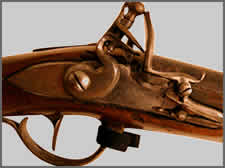- 01: Introduction
- 02: History
- 03: Propellants, Firearms, and Ammunition Development
- 04: Modern Firearms Manufacture
- 05: Small Arms Ammunition
- 06: Evidence Handling Procedures
- 07: Equipment and Instrumentation
- 08: Examination of Firearms
- 09: Cartridge and Shotshell Examination
- 10: Characterization and Evaluation of Fired Projectiles
- 11: Bullet Comparison and Identification
- 12: Gunshot Residue and Distance Determination
- 13: Toolmark Identification
- 14: Communicating Results
- Resources


Flintlock
Home > Propellants, Firearms, and Ammunition Development > Evolution of Firearms > Ignition Systems > Flintlock
The next evolutionary step, the flintlock, was small but important. To the casual observer, the difference between the snaphaunce and a true flintlock is subtle; each uses flints for sparks. Those not familiar with firearms technology may incorrectly identify a snaphaunce as a flintlock.

Early ignition systems held the charge of priming powder in an open pan above the lock, exposing the priming charge (powder) to the environment. The priming charge could be rendered inert by rain. A gust of wind could empty the pan of powder, as could merely tipping the muzzle up or down too far. No powder in the pan meant a misfire; the sparks alone could seldom reach the main charge through the flash hole. Some designs were fitted with sliding or pivoting pan covers that were manually moved for firing. This worked until the shooter forgot to move it or when the part was damaged. Finer designs incorporated an automatic pan cover that could be pushed aside as the hammer fell across the anvil. However, finely fitted covers were prone to damage from flame and corrosive residue, potentially causing the firearm to jam.
The flintlock overcame a problem that dated back to the time of early firearms. The small but critical improvement that separates the flintlock from the snaphaunce is the frizzen. This device combines the functions of a priming pan cover and an anvil into a single unit. Compared to any previous pan-cover system, this simple improvement proved significant to the history of firearms technology. When ready for firing, the frizzen is in the down position, fully covering the priming charge in the pan. When the cock falls, the flint strikes the curved anvil portion of the frizzen, producing the required sparks. Like the snaphaunce, the frizzen pushes up and opens the pan cover, allowing the sparks to fall into the priming charge.
The flintlock allowed the soldier or hunter to carry arms that were truly ready for action at a moment’s notice. The weapon was relatively safe yet required only that the user raise and cock it before taking the shot. No one had to remember to open a pan cover. The frizzen was not completely waterproof; it could not protect the priming charge against heavy rain or submersion. However, it provided reasonable protection in light rain and eliminated the wind problem.
An evolutionary rather than a revolutionary change, the flintlock was relatively simple, inexpensive (in its basic form), and well suited to military use. The French issued their first true flintlock military arms in 1717 and retained the basic pattern until 1842. The story was similar in other countries; the flintlock reigned on the battlefield for at least a century. New developments in the sporting arms field would ultimately supplant flint ignition and lead to the cartridge firearm.




